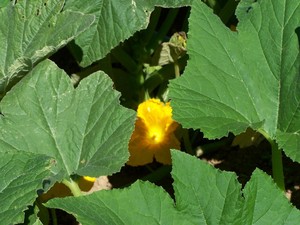28 Feb Sat 2009
Certified Habitat
Greenjeans Farm and CSA becomes the NWF 113,581 Certified Wildlife Habitat
The National Wildlife Federation has announced that Greenjeans Farm & CSA located in Potter Valley is now recognized and an official Certified Wildlife Habitat site.Greenjeans Farm attracts a variety of birds, frogs, and other wildlife, while helping to protect the local environment.
The Wildlife Habitat certification program began in 1973 and since has certified over 110,000 habitats nationwide, including the special 100,000th certification of the U.S. Botanic Garden’s National Garden in Washington, D.C. at the base of our nation’s Capitol.
The majority of Certified Wildlife Habitat sites represent the personal commitment of individuals and families to provide important refuge for wildlife near their homes, but NWF has also certified more than 3100 schools and hundreds of business and community sites.The average habitat is between one half and one third acre, but certified sites can vary from urban balconies to thousand-acre farms.
Any habitat enthusiast can create a certified habitat and learn the rewards of gardening for wildlife.NWF teaches the importance of environmental stewardship by providing guidelines for making landscapes more hospitable to wildlife.In order to become certified, a property must provide the four basic elements that all wildlife need:food, water, cover and places to raise young; and must employ sustainable practices.Habitat restoration is critical in urban and suburban settings where commercial and residential development encroaches on natural wildlife areas, limiting the availability of resources wildlife need to survive and thrive.In addition to providing for wildlife, certified habitats conserve our natural resources by reducing or eliminating the need for fertilizers, pesticides, and/or irrigation water, which ultimately protects the air, soil and water throughout our communities.
Jeff Adams, owner of Greenjeans Farm sums it up:“Seven years ago we moved to this abandoned piece of land envisioning a Farm, the soil was sog in winter and hard packed clay in summer and the only wildlife we entertained were Ticks,ants,earwigs,flies and gnats from the vineyard across the street.By using Organic practices, building and feeding our soil first, and using no pesticides or synthetic fertilizers, we have enabled a rich and varied environment in which many birds, bees, butterflies, frogs, bats and other animals grow and flourish.The bird that eats a couple of our plums, cherries or raspberries also eats thousand of bugs that are trying to get to the vegetable garden!We have a couple of covey of quail that live in the blackberry bushes at the bottom of the property. And many finches and hummingbirds of all colors.We have bats that from time to time fly into the bedroom at night if we leave the door open but they also eat something like three times their weight in bugs a night. The toads like to eat the slugs and they are very comical popping out in the strangest places!And it is not unusual to have a brightly colored tree frog jump out of the sink overflow drain while you are brushing your teeth in the morning if you leave the bathroom window open! They take care of everything BUT the weeds!The real reward is when you are working in the field and you hear the wooosh wooosh of giant wings and look up to see an eagle or a giant red tail hawk coming right atyou and then you watch it soar over your head and high into the sky and dive down to catch a fish in the pond across the street”
Creating habitats not only helps wildlife, it can help reduce global warming, pollution and save energy costs as well.Burning fossil fuels to heat and cool our homes and maintain our lawns releases carbon dioxide into the atmosphere, which is the main greenhouse gas responsible for global warming.Strategically located trees and other native vegetation can insulate our homes for heat, cold and wind, reducing our heating and cooling needs and thus our carbon emissions.Wildlife friendly native plants don’t need constant maintenance from gas guzzling lawn mowers or fertilizers that require fossil fuels to manufacture and often leave harmful chemical salt residue.An additional benefit is that plants actually absorb carbon dioxide, helping to further reduce the amount of greenhouse gases in the atmosphere.All of this adds up to increased areas available for wildlife and a better quality of life for all.
Habitats can also produce an added value to your home.A beautiful, living landscape is an acctractive element to many potential home buyers looking to share their homes with Mother Nature.
The mission of the National Wildlife Federation is to inspire Americans to protect wildlife for our children’s future.


Congratulations!